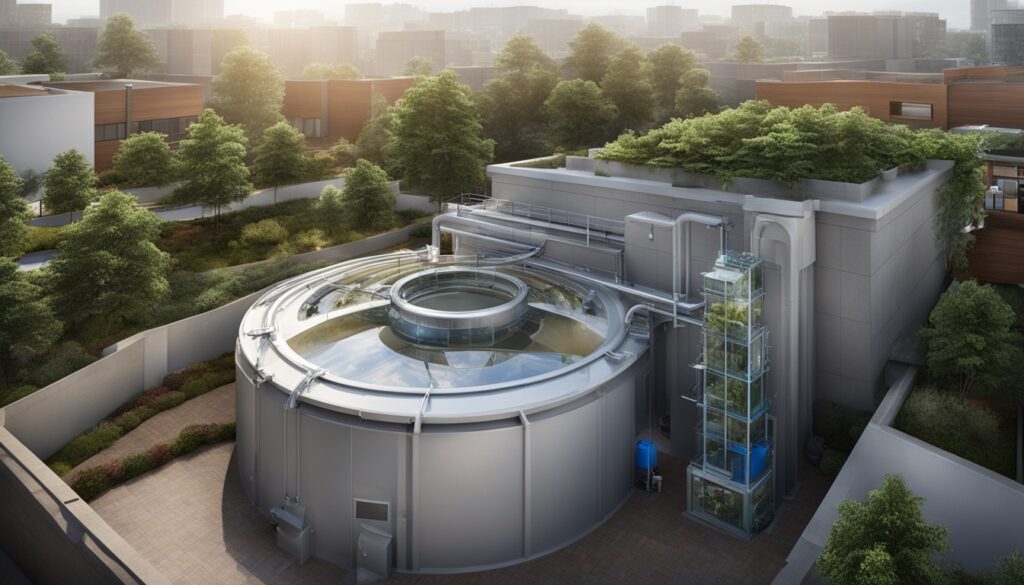
Did you know a 1,000-square-foot roof can gather about 600 gallons of rain per inch? This fact shows how great rainwater harvesting can be for city buildings. By 2050, up to 2.4 billion people might face water shortages. So, using rainwater wisely is key. Cities around the world are adding rainwater systems to buildings to prepare for this.
Now, saving water is a must. Buildings in cities can use rainwater for things like watering plants and flushing toilets. The USA, New Zealand, and Australia are rewarding people for saving water. They use rules and money back offers to encourage them.
In Germany, the Schwalbe Hybrid Building uses old materials and rainwater for its roof gardens. Google Bay View in California has a plan to use water in a good way. These examples show rainwater harvesting is important in modern city design. Green building water systems are not just an option, but a need. They help lessen harm to the environment while tackling worldwide issues.
The Importance of Rainwater Harvesting in Urban Areas
As cities grow, we need smart ways to handle water. Rainwater collection, stormwater management, and greywater recycling are key. They help use water wisely and protect our environment. This section looks at how rainwater harvesting in urban areas helps. It tackles water shortages, controls stormwater, and saves water in cities.
Alleviating Water Scarcity
Rainwater collection is a great answer to the world’s water problems. It lets buildings in cities collect rain, cutting down on city water use. This saves money and eases pressure on water sources. Governments offer benefits to encourage collecting rainwater. This is important in places like China, with many cities running out of water.
Reducing Stormwater Runoff
Heavy rains in cities can cause floods. Stormwater management systems like rooftop rainwater harvesting help absorb water. They reduce flooding and keep rivers clean by filtering rain. With more concrete everywhere, managing rainwater is a must to prevent urban floods.

Enhancing Urban Water Conservation
Using rainwater systems saves city water. Rainwater is great for irrigation, toilets, and more. It also helps make cities greener and more eco-friendly. Teaching people about saving water encourages them to use these systems.
Examples of Successful Implementations in Urban Buildings
Many city buildings are now using rainwater harvesting. For instance, Germany’s Weitblick Innovation Campus has green roofs and uses rain barrels. The Carlsberg Central Office also saves a lot of water with its rainwater collection system. These cases show that smart design and technology can make city water management better.
Rainwater Harvesting Systems for Urban Buildings
Urban areas need to use space wisely for water. Advanced systems like green roofs help with water and look good. They use permeable pavements and underground systems for stormwater, reducing runoff and helping groundwater.

Where space is scarce, innovations like cisterns fit well in urban places. These systems, with wireless monitoring, make water management easy and efficient.
Following the law is key for water practices. Countries like New Zealand, Australia, and the US have rules. New Zealand allows rainwater for non-drinking uses. Australia gives money back for following water tank rules. In the US, states like California and Texas reward rainwater use against water scarcity.
Rainwater systems in cities are getting better, using tech for drinking and other water needs. This helps the world by making water use smarter and sustainable. Technology like the Smart Water indicator helps.
Good rainwater systems need several parts: places to catch water, ways to move it, storage, and ways to use it. For example, a big roof can gather a lot of water from rain. Using green roofs in cities captures water for use. This saves money on water bills by using rainwater for things like gardens and washing cars.
Rainwater setups help stop flooding by managing stormwater. They cut down on city water use, promoting sustainable water management. Permeable pavements let rainwater go through, used in places like parking lots and paths.
Conclusion
Urban rainwater systems help cities in many ways. They make cities more able to handle water needs in a green way. For example, Grundfos in Texas uses rainwater for many water needs. This has helped them earn a top award for saving water.
Places like Bridgeland use special ponds and systems to manage stormwater. The Houston Zoo collects rainwater for plants and to clean animal areas. These efforts help prevent floods, lower erosion, and help local water sources. They also make cities less reliant on underground water.
Rainwater systems are used worldwide and are not new. In India, they have been used for a long time. In Dhaka, Bangladesh, new uses for these systems are being found. They are important for growing cities to manage water better. By using nature-friendly ways, cities can be ready for the future. They can handle water needs in smart, eco-friendly ways.